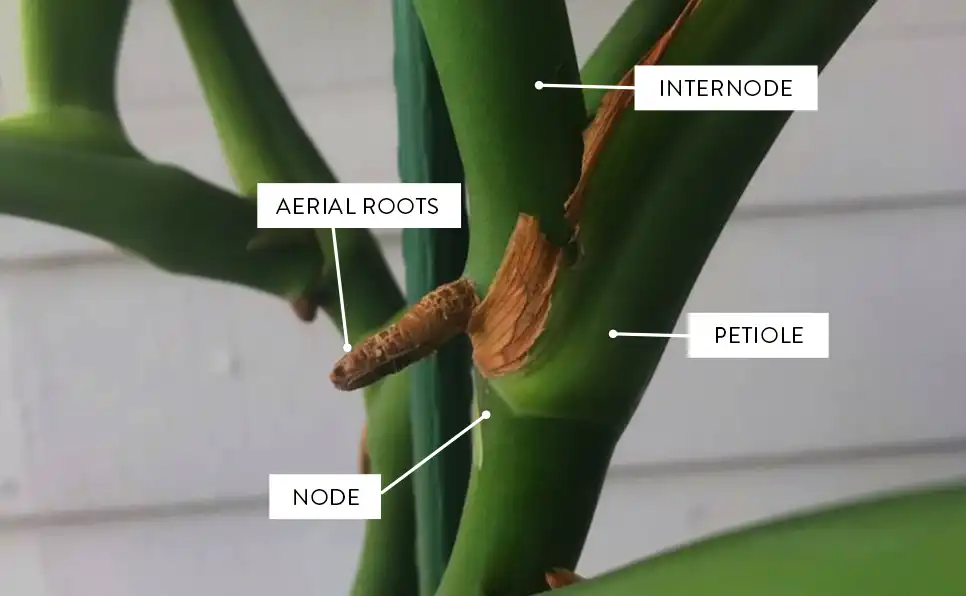Are you planning to ramp up the aesthetics of your home or workspace organically while cleansing the aura and the air, all at the same time? Then try planting Monstera deliciosa, also commonly known as, the Swiss Cheese Plant. The scientific name of this species defines its two main characteristics. The genus Monstera comes from the Latin word, meaning monstrous, hailing from its large leaves while the specific name deliciosa signifies the delicious fruit, this plant bears. Often described as a joint taste of mango, banana, and pineapple, the fruit of the Swiss Cheese plant, once ripens, is a treat to the palate of many.
Swiss Cheese Plant is often the “go-to choice” for anthophiles because of its low maintenance, ease to grow, and high resistance to varying weather conditions. Mainly used for ornamental quality, Monstera deliciosa also helps in purifying the air, and dehumidifying abilities and is considered an exotic feng-shui collectible. The characteristic feature of this tropical plant is its fenestrated leaves for which it is prized.
Swiss Cheese plant can grow to a huge size and features aerial roots that grow downwards from the stem. Once it touches the ground, it can spread out and binds to the soil. Native to tropical forests of North & South America, Monstera deliciosa has found its way to living rooms because of its capability to adapt to a wide range of conditions.
Before we learn how to propagate the Swiss Cheese Plant, it is important, we know the basics of cutting.
Cutting Swiss Cheese Plant:
- Select the main vine or branch.
- Get rid of the aerial roots and dried leaves.
- Identify the nodes.
- Cut the vine above or below the nodes. Do not cut at the nodes. Cut at the benign area.
- You can choose to propagate a single node. If the spacing between the nodes is less, you can propagate multiple nodes.
3 ways to Propagate Swiss Cheese Plant:
Once you are done cutting from the mother plant, you can propagate the Swiss Cheese Plants in three mediums:
- Soil Propagation
- Water Propagation
- Moss Propagation
Each of the propagation method is fairly simple as the plant doesn’t require much effort to help it grow. If you want an easier way to propagate Swiss Cheese plants, the water propagation technique is the answer. Whereas, if you want to save time, you might wanna go for the soil propagation method. And if you are a pro at growing plants, and gardening, and you know what you are doing, Moss propagation is recommended as it yields the best result.
Soil Propagation: This process requires around one to three months for the Swiss Cheese root cuttings to show any sign of development. But most importantly, this will save you from the need to repot the plant and hence saves time.
Choose a pot proper for the size of the root cuttings. Make sure the pot has holes at the bottom because Monstera deliciosa thrives well if the soil can drain excess water. Excess clogged water will stunt the growth of the plant. Fill the pot with normal potting soil that drains well. Potting soil can be made up of 60% peat moss or coco coir, 20% Pumice or coarse sand or perlite (for better drainage), and 20% organic matter like compost or worm casting. Also, ensure that the potting soil is free of water-retentive gels.
Place your root cuttings in a way that buries the nodes under the soil.
Water Propagation: The second and easiest way to propagate the root-cuttings of the Swiss Cheese Plant is by water propagation. Transfer the root-cuttings to a water jug. Make sure the vessel you choose is sufficiently large because once the plant starts to propagate, it’ll be cumbersome to transfer it to a new pot. Submerge the root-cuttings or the vine in a way that the nodes are fully underwater. In about three to four weeks, you should see new roots and small leaves sprouting from your freshly cut vine. That way, you’ll know the propagation was successful.
Moss Propagation: For this technique, you can use Sphagnum moss. Mix some water with Sphagnum moss and put it in a pot. Dip your root cutting into the mixture, till the mixture a little, and fill the pot with some more Sphagnum moss. Make sure the nodes are covered. Sphagnum moss will develop hefty roots.
Once you are done with propagating, now it is time to re-pot the newly propagated Swiss Cheese Plant.
Repotting:
Once the Monstera deliciosa starts to grow, you need to re-pot it so that the roots can grow. The more the root system develops, the bigger the leaves will be, and the better the fenestrations. As the plant keeps getting progressively bigger, ensure to re-pot accordingly. Use soil that drains well and a pot that has holes at the bottom to prevent water clogging.
Light:
The fact that Swiss Cheese plant can be grown indoors rely on the aspect that they do not need direct sunlight. Avoid direct sunlight as it might burn or cause mechanical damage to the plant. Keep your plants beside curtained windows and keep rotating the plant so that all parts of it get even indirect light. You can also use grow lights to help support their development. The light requirement is low to medium.
Water:
As mentioned, Monstera is a typically low maintenance plant. You can water them once a week in summer and twice a week in winter. If the soil is wet, you can wait before watering it again. In presence of excess water, Monstera deliciosa experiences stunted growth.
Humid:
The Swiss Cheese plant loves humidity. You can use spray canisters to keep the air moist or even use a humidifier. During winters, when the weather is dry and radiators are on, make sure, your plant is placed in a well-ventilated position.
Optimal Temperature:
The best temperature for unimpeded growth of Monstera deliciosa is 65 – 85 degrees Fahrenheit.
Fertilizer:
If you are using standard potting soil, you do not need to fertilize the plant much. But if you are using fertilizers make sure you follow the guidelines on the packaging. Use nitrogen, potassium, and phosphate-based fertilizers only.
Staking:
You can use staking if your plant is getting top-heavy and growing lopsided. Otherwise, you can avoid staking. For the aerial roots that are hanging, you can either prune them or guide them back to the soil.
Pests:
Spider mites, thrips, and mealy bugs often infest Monstera deliciosa. Most of which can be cleaned manually with a simple wash. You can also use horticultural dormant oil and Neem oil to help keep your Swiss Cheese Plant in good health.
By following these simple steps, you can help the growth of your Swiss Cheese Plant and get those lush green fenestrated leaves to adorn your indoors and uplift your mood.



